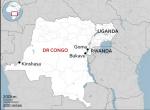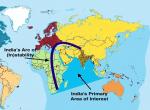On October 20, 2018, US president Donald Trump had declared his administration`s intention to withdraw from the Intermediate Range Nuclear Forces Treaty (INF) which was signed on February 2, 1987 by one of his predecessors, Ronald Reagan and his Soviet counterpart, Mikhail Gorbachov. US secretary of state, Mike Pompeo has recently confirmed his president`s decision. The INF prohibits testing and deployment of ground-base ballistic missiles and ground-launched cruise missiles in the 500 – 5500 km range and shorter range missiles in 500 -1000 km range category. The Treaty was de-facto the first step in reduction of deployed nuclear warheads and their launchers. In their joint statement in 1987, both the Presidents, Reagan and Gorbachov, had described the INF as historic both for its objective of complete elimination of an entire class of US and Soviet nuclear arms, and for the innovative character and scope of its verification provisions.
The US government`s decision has been described as a response to Russia`s alleged violations of the INF by developing nuclear missiles and launch vehicles in the prohibited category and deploying such missiles within strike distance of Eastern European states which are presently part of NATO. The former US administration of President Obama had also accused Russia of deploying nuclear-capable ground launched missiles with 2000 km range (SSC-8) in Europe that are non-complaint with the INF. The Trump administration`s latest decision is therefore indicative of a similar posture on the Treaty, though its timing on withdrawal from its purview has its own significance. It may however, be appropriate to recapitulate at this juncture the observations of John Bolten, the present US National Security Adviser, in 2011, in his personal capacity. Bolten had then opined that, the US must either expand the INF Treaty`s membership – thereby probably implying the inclusion of more nuclear weaponised countries like China or even North Korea within the ambit of the Treaty, or abrogate it entirely so that the US Government can rebuild its deterrent capability. President Trump now seems to have exercised the latter option.
The Russian Government`s response to the Trump administration`s decision, has been categorical to the extent of declaring, on February 2 this year, the suspension of its obligations under the INF. However earlier in the context of gradual deterioration in its bilateral strategic relations with US, Russia had threatened in March 2018 itself that it was developing a new generation of nuclear weapons including cruise missiles in the 500-1000 km range and nuclear torpedoes. Now, while reneging from Russia`s obligations under the INF, Moscow has indicated Russia`s intention to develop previously banned nuclear weapons but not deploy them till US did, and also avoid any dialogue with Washington on nuclear disarmament and the consequences of collapse of the Treaty. When appraised against the backdrop of US`s withdrawal from the Anti-Ballistic Missile Treaty of 1972 with the Soviet Union, by the US government under president George Bush in June 2002, and looming uncertainties on implementation of the New Strategic Arms Reduction Treaty of February 2011, collapse of the INF may be deemed to herald the unraveling of the broader nuclear disarmament architecture painstakingly built up by the leaders of the major nuclear powers since the end of World War-II.
The INF was a landmark disarmament measure. The Treaty was signed by Reagan and Gorbachov in 1987 in the terminal phase of the Cold War of the early post-Second World War period. The INF was a true step towards nuclear disarmament by devising a time-bound and verifiable process for elimination of more than 2600 nuclear weapon systems within a particular threshold or strike distance, while excluding the strategic inter-continental ballistic missiles (ICBMs) from its purview. Thus, mutually assured destruction capability was retained with the super powers for strategic stability, while nuclear weapons at lower thresholds and deployed in advanced theatres close to the Soviet heartland and the West European core of NATO, were eliminated.
Dismantling of the Warsaw Pact, change of polity and regimes in the former Soviet Bloc countries, and subsequent inclusion of many East European countries in NATO, have virtually raised a new political and not-too-comfortable a spectre before Moscow, and also eliminated the strategic depth the Russian state (the major component of the former communist entity of the Soviet Union) enjoyed vis-à-vis the NATO countries. As a consequence, Moscow seems to have lately become assertive on the western flank of Russia in relation to countries like Ukraine, Georgia and the Baltic States like Lithuania, Latvia and Estonia. Moscow`s strategic concern vis-a-vis Eastern Europe and NATO have been elucidated by the President Putin and his government, on many occasions. The extension of NATO`s eastern flank towards Russia over the past two decades has been the most fundamental strategic development inimical to Russia. Russian attempts since 2014 to dominate Ukraine geopolitically, consolidate the dominance by political interference in governance of that country, and finally by sheer military aggression to the extent of deploying Russia equipped irregular forces, have to be viewed in the above-mentioned context. Russia`s attempt to develop land-based ICBMs with 2000 km range and the land version of the sea-launched Kalibr Cruise Missiles of 1000 km range have to be viewed in this context.
The essence of nuclear disarmament efforts among the established nuclear powers, particularly the US, UK and former Soviet Union, was to limit the spread of nuclear weapons both vertically and horizontally, while retaining their nuclear weapons-based strategic pre-eminence. France, a Western ally, was the first to break out of this strategic mould by developing its `Force de-frappe` or independent nuclear weapons force deterrent in the 1950s while remaining a part of the NATO. China broke the nuclear stratification by becoming the fifth declared nuclear military power in 1964. While the Partial Test-Ban Treaty of 1963 among US, UK and the then Soviet Union was the first international disarmament treaty post World War-II, this instrument could not contain the augmentation or further refinement or sophistication of the nuclear weapons arsenal of the four nuclear powers of that time, viz., US, UK, Soviet Union and France. China, to protect its strategic autonomy and its all-round sovereignty, which was perceived to be under threat from the US as well as the Soviet Union after the Sino-Soviet split, did not subject itself to any disarmament measure within the confines of an internationally accepted treaty.
It was broadly within the above-stated backdrop that, the INF has to be viewed as a progressive step towards eliminating at least some of the nuclear missiles and their launchers in a verifiable manner. Other disarmament agreements like the Strategic Arms Limitation Treaty of 1972 between US and the Soviet Union, Nuclear Non-Proliferation Treaty of 1968 and the Anti-Ballistic Missile Treaty of 1972 were basically to retain the nuclear pre-eminence of US and Soviet Union (later Russia) in an assured manner, their survivability in case of an unexpected first strike from a nuclear adversary, and also to prevent nuclear weaponisation of emerging powers like India.
In the backdrop of the above scenario, it may be advisable that an international framework be drawn up and institutionalized on a multi-lateral basis, which controls adventurism by any of the presently established nuclear weapons equipped or capable powers, and also leads to reduction in the existing nuclear weapons stockpiles. Something beyond an institution like the now withered INF is required. Multi-lateralisation of international disarmament efforts is also the need of the hour. India, because of its past track record of promoting persistent efforts for universal disarmament during the Cold War era, abjuring nuclear weapons for the first 50 years of its existence and adopting a restrained nuclear policy in the matter of development, deployment and its security posture, may be able to play a catalytic or persuasive role in the matter.
First of all, US and Russia have perforce to arrive at an understanding on a broader architecture of nuclear disarmament. It may not be possible to salvage the INF as it had operated for the past nearly 30 years because of the dynamics of political changes in Eastern Europe such as inclusion of some of these states within NATO, advance deployment of platforms capable of delivering tactical and strategic nuclear weapons against Russia with short lead-time, and consequent Russian suspicion on US`s and also its NATO allies` security stance vis-à-vis Russia. But a dialogue process should start without further delay. Heiko Mass, the German foreign minister has urged US to consider the consequences of its withdrawal from the INF. Federica Mogherini, European Union (EU)`s high representative for foreign affairs and security policy, has lamented on the unfolding of the INF which, in her words, had “contributed to the end of the Cold War and constituted a pillar in European security architecture”. While the dominant nuclear powers, ie. US and Russia have to be lynchpin in any acceptable nuclear disarmament arrangement, the European Union, which encompasses a large number of East European states, could take the initiative.
Countries like India and Pakistan and even China could consider participating in a new disarmament subset agreement patterned on the INF model in Asia, which limits development and deployment of intermediate range and shorter range nuclear missiles in a verifiable manner. The issue of development and deployment of tactical nuclear weapons for war fighting in concert with conventional forces as per Pakistan`s policy in the Indo-Pak context, which is a destabilizing factor in the bilateral relations between these two countries, could also be addressed. China`s security concerns will however, have to be suitably factored in or addressed in such a disarmament institution. Proliferation of anti-ballistic missile shields may concomitantly be proscribed to enable retention of mutual strategic strike capability which will serve as an assurance against adventurism on the part of the countries within its fold.
However, a beginning is required to salvage or re-draw an institution on the European INF model. This may be an onerous task for the Trump presidency reckoning a few imponderables like its posture towards emerging or likely nuclear powers like North Korea and Iran, premeditated ambivalence on the Israeli nuclear arsenal maintained, and lack of synchronicity in posture with its NATO allies. The present disarmament scenario is too variegated and does not seem to permit a coherent disarmament framework to take care of the security needs of the major nuclear weapon powers and those at lower thresholds. Nevertheless, the extent and dimensions of threat to international peace and security will be much more in the absence of region or theatre-specific institutions like the INF.
(The author is a retired IDAS officer who has served in senior appointments with Government of India and State Governments)
(The paper is the author’s individual scholastic articulation. The author certifies that the article/paper is original in content, unpublished and it has not been submitted for publication/web upload elsewhere, and that the facts and figures quoted are duly referenced, as needed, and are believed to be correct). (The paper does not necessarily represent the organisational stance... More >>
Image Source: https://orientalreview.org/wp-content/uploads/2017/11/65224-004-C22EA8B0.jpg











Post new comment